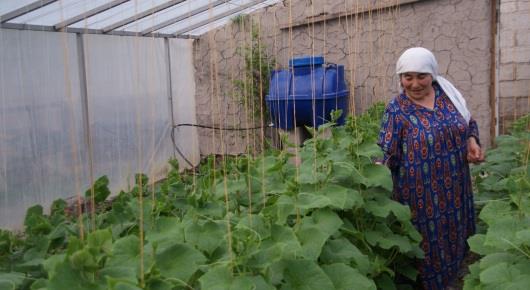Drip irrigation boosts water efficiency for Tajik farmers

In Tajikistan, irrigation water is the bottleneck of crop production. And with water scarcity on the rise due to climate change-induced weather extremes, the situation is getting even worse, particularly in rural areas.
At this time of year, with the long dry periods and high temperatures of spring and summer to come, rural communities in parts of Tajikistan are facing increased fragility, water shortages, and intensification of land degradation and desertification.
There are solutions, however. Drip irrigation, for example, offers hope for drought-prone areas.
To this end, women-led households in the Abdurahmoni Jomi, Vakhsh and Yovon districts of Tajikistan’s Khatlon province have received 70 sets of drip irrigation kits, provided by FAO and the Israeli Embassy in Uzbekistan in close collaboration with public organization “Women of Khatlon.” The drip irrigation kits will allow these families – who already have experienced decreased irrigation water availability – to produce more food in their kitchen garden plots.
“Drip irrigation is not merely an additional mean of increasing productivity, but one of the essential components for modernizing agricultural practices that respond to droughts and lack of water availability,” said Oleg Guchgeldiyev, FAO Representative in Tajikistan. “The introduction of proper agricultural water management techniques would significantly increase the resilience of local populations, particularly women, to overcome subsequent natural shocks and improve agricultural production with scarce natural resources.”
The irrigation kits, which are designed for kitchen garden or orchard irrigation, include everything the beneficiary farmers will need for irrigation, from a high-capacity water tank and drip lines to vegetable seeds and saplings for growing.
The low-pressure gravity irrigation systems can be used for a variety of crops. Precise controls allow water to be deposited at the base of each plant in just the right amount, maximizing efficiency and minimizing waste.
“Considering the low maintenance and energy costs, this could have a significant potential throughout the country, where most farmers own small-size plots,” Guchgeldiyev added.
The distribution of the kits ends today. Before that FAO also held trainings on the proper installation and operation of the drip irrigation systems. The farmers involved were encouraged to share their new knowledge with other beneficiaries in their communities.
Estimates are that, due to climate change, irrigation water needs for staple agricultural crops are likely to increase by 20 to 30 percent. To mitigate those negative effects, knowledge and affordable technologies are key.
The drip irrigation systems were delivered as part of the FAO-run Central Asian Countries Initiative for Land Management.
8 April 2019, Dushanbe, Tajikistan
